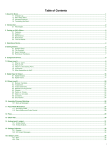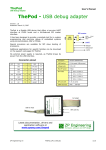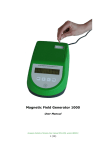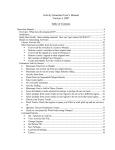Download Ethernet CAMAC Crate Controller User`s Manual
Transcript
JENET – Ethernet-based CAMAC controller
JENET
Ethernet
CAMAC
Crate
Controller
www.zpeng.com/jenet
User’s Manual
P/N:
JNT01
Ver:
1.0.2
Date:
25 Feb 2004
ZP Engineering srl
Via Michelangelo Peroglio, 15
00144 Rome, ITALY
www.zpeng.com
ZP ENGINEERING srl
JENET User’s Manual, v. 1.0.2
1/28
JENET – Ethernet-based CAMAC controller
INDEX
1 General information ............................................................................................... 4
1.1 Warranty ......................................................................................................... 4
1.2 System overview .............................................................................................. 5
1.3 Summary of features ........................................................................................ 5
2 Starting up............................................................................................................ 6
3 Serial port control .................................................................................................. 7
4 Startup options...................................................................................................... 7
4.1 Startup flags.................................................................................................... 7
4.2 Jumper settings................................................................................................ 8
5 Remote control ...................................................................................................... 9
5.1 TCP control socket ............................................................................................ 9
5.2 ESONE library ................................................................................................ 10
6 Local web server .................................................................................................. 11
6.1 Commands page ............................................................................................ 12
6.2 NIM I/O page ................................................................................................. 13
6.2.1
Input section ........................................................................................ 13
6.2.2
Output section ...................................................................................... 14
6.2.3
COMBO section ..................................................................................... 14
6.3 System settings page...................................................................................... 15
6.4 Diagnostics page ............................................................................................ 16
7 Local scripting ..................................................................................................... 17
7.1 Lua scripting language .................................................................................... 17
7.2 Lua engine in Jenet......................................................................................... 17
7.2.1
Bit manipulation extension ..................................................................... 18
7.2.2
Socket commands for Lua control............................................................ 18
7.2.3
Jenet Script Manager (jsm) .................................................................... 19
7.2.4
Scripting on Jenet ................................................................................. 19
8 Firmware Upgrade................................................................................................ 20
9 NIM subsection .................................................................................................... 20
9.1 Default button................................................................................................ 20
9.2 Inputs........................................................................................................... 21
9.3 Outputs......................................................................................................... 22
9.4 COMBO I/O.................................................................................................... 23
10 Commands reference.......................................................................................... 24
11 System Specifications ......................................................................................... 28
ZP ENGINEERING srl
JENET User’s Manual, v. 1.0.2
2/28
JENET – Ethernet-based CAMAC controller
This log identifies those portions of this document, which have been revised since the original issue and the date of each revision.
Rev
Summary of changes to previous version
1.0
1.0.1
Date
Approval
First version
15/01/04
UZ, PP, MV, FP
Notes added to sections 3, 5.1 and 8.
11/02/04
UZ
24/02/04
UZ
Lua binary operators added (section 7.2.1 and section 10)
1.0.2
Control socket commands for Lua control added (section 7.2.2)
Revised jsm description (section 7.2.3)
ZP ENGINEERING srl
JENET User’s Manual, v. 1.0.2
3/28
JENET – Ethernet-based CAMAC controller
1 General information
This manual is intended to provide a reference for operating and programming JENET, an
Ethernet-based CAMAC crate controller.
1.1 Warranty
HARDWARE
ZP Engineering srl warrants the JENET JNT01 product to operate within specifications under normal
use and service for a period of 2 (two) years from the date of shipment. Component products,
replacement parts and repairs are warranted for 90 days. This warranty extends only to the original
purchaser.
Should the product, in ZP Engineering's opinion, malfunction within the warranty period, ZP
Engineering will at its discretion repair or replace the product upon receipt with an equivalent. Any
replaced parts become property of ZP Engineering. This warranty does not apply to a product that has
been damaged due to accident, misuse, abuse, improper installation, usage not in accordance with
product specifications and instructions, natural or personal disaster, or unauthorized alterations, repairs
or modifications.
Please note the following:
−
The warranty applies only to defects in workmanship.
−
The warranty makes no claims regarding suitability of the product for a particular use or
environment.
−
A serial number is required for any warranty service.
−
Proof of purchase may be required; ZP Engineering srl accepts originals, photocopies and
faxes as proof of purchase when required.
−
Unauthorized repairs to a ZP Engineering board level product will void the warranty offered by
ZP Engineering srl.
−
ZP Engineering srl reserves the right to refuse to service any product that has been altered,
modified or repaired by non-ZP service personnel.
−
Standard warranty service consists of repair upon receipt. You are responsible for the cost of
shipping the product to ZP. ZP pays the cost of returning a product to you.
−
ZP Engineering srl reserves the right to replace the product with a service product at their
sole discretion at any time.
−
This warranty does not apply to the software component of a product.
−
Components and schematics are property of ZP Engineering srl and are not available to end
users.
SOFTWARE
Software included in the unit has been carefully tested, but is supplied “as is” with no warranty
covering detailed performance. Critical problems are covered by a software warranty for a period of 3
(three) months from the date of shipment. Within this period, software upgrades will be provided;
software upgrades will be performed by the customer using the available tools.
DOCUMENTATION
The documentation included with the unit represents the latest version document, and is
continually refined end edited. Please refer to the support web site at www.zpeng.com/jenet
for the latest version.
ZP ENGINEERING srl
JENET User’s Manual, v. 1.0.2
4/28
JENET – Ethernet-based CAMAC controller
1.2 System overview
JENET is a complete CAMAC controller that allows advanced interaction by means of
standard Ethernet services, such as a local web server and TCP socket based communication
protocol. The basic hardware architecture of JENET is illustrated below.
CAMAC bus
CAMAC
bus
control
LAN 10/100
Front-panel
RJ45
LAM
32 bit
4 NIM
in
RISC PROCESSOR
uClinux OS
NIM
input/output
control
Front-panel
serial port
4 NIM
out
Voltage
monitoring
COMBO 1
CRATE power
supplies
COMBO 2
A local processor runs a version of Linux optimized for low memory footprint; a CAMAC bus
control subsection handles all bus access operations and interactions, and a separate NIM
subsection manages I/O signals located on the front panel.
1.3 Summary of features
CAMAC
bus access
o
Full CAMAC bus control, including LAM detection
o
Plugs into slots 24 and 25
Local
NIM I/O
Section
o
4 outputs, 4 inputs, event counters, 2 COMBO I/O (trigger/busy) modules
o
programmable pulse generators
o
input event counters
o
NIM default settings can be reloaded with front panel button
Remote
Control
Library
o
ANSI C remote control library derived from the ESONE standard, with
extensions to control local resources
o
Remote control of all functions through TCP socket
Local
Web Server
o
Dynamic local web server allows advanced monitoring and control without the
need to install dedicated software (perfect for crate setup and maintenance)
o
User page with results from script
Advanced
Scripting
Engine
o
Embedded script interpreter allows local execution of C-like code, with full
control on CAMAC and NIM functions
o
No need to install cross-compilation toolchains
Front Panel
Indicators
o
X and Q signals on last access
o
4 user LEDs (controllable from script)
o
Fault, connection status and NIM default indicators
ZP ENGINEERING srl
JENET User’s Manual, v. 1.0.2
5/28
JENET – Ethernet-based CAMAC controller
2 Starting up
1. Please insert the controller into slots 24 and 25 ONLY of a standard CAMAC crate
(rightmost when looking the crate from the front side)
2. if default network settings are compatible with your setup, connect a LAN cable to the
front-panel RJ45 socket
3. Power up the CAMAC crate
4. Wait about 20 seconds to allow completion of operating system boot
5. If default network settings are not suitable for your network environment, connect a
terminal to the front panel serial port and make the necessary variations (see Serial
port control section). After that, reboot (either by cycling the main power or by
pressing the RESET front panel button) and wait about 20 seconds.
6. For instant gratification, please open your favorite browser (on a host connected to
the same LAN used by Jenet) and point to its IP address; if default settings apply, the
default IP address is 192.168.0.98. From the werb server pages, you already have
control over the NIM I/O section and the possibility to perform individual commands
on the CAMAC bus.
NIM output 1
can be set as a pulse
generator
Power supply
presence
indicators
NIM outputs
Status of X
and Q signals
on last CAMAC
access
(LEDs are ON when
output is active)
User LEDs
COMBO trigger/busy
sections
(controllable from
Lua and socket)
(LEDs are ON when
output is BUSY)
FAULT LED
Connect status LED
(ON when a socket
connection is active)
NIM inputs
Restore default NIM
I/O configuration
Pushbutton and
external SYSTEM
RESET
ZP ENGINEERING srl
JENET User’s Manual, v. 1.0.2
•
IN 1 and 3 can be set
as event counters
•
IN 2 and 4 can be
enabled as external
reset for event
counter and /or
COMBO sections
6/28
JENET – Ethernet-based CAMAC controller
3 Serial port control
A serial port connector located on the front panel allows the user to modify system
settings; this procedure is required if current network parameters are incompatible with the
local network. It is also possible to modify startup options.
Connection parameters are the following: 38400 baud, 8-N-1, no flow control. Echo is not
enabled on the serial port, so please enable character echo on your serial terminal.
The following commands are available:
help
Provides a quick list of commands on terminal
setip <new IP addr>
sets a new IP address, to be written in the format aaa.bbb.ccc.ddd
setmask <new mask>
sets a new IP mask
setgw <new gw addr>
sets a new gateway IP address
setdhcp <0|1>
if set to 1, enables the local DHCP client
getip
getmask
Allows retrieval of current network settings
getgw
getdhcp
setrob <0|1>
if set to 1, enables the Lua Run-On-Boot option
setcscan <0|1>
if set to 1, enables the Crate Scan function (executed at startup only)
getrob
Allows retrieval of current startup settings (Lua Run-On-Boot and Crate Scan)
getcscan
Note:
The front-panel connector requires a straight serial cable (pin 2 to
pin 2, pin 3 to pin 3); only RX and TX are required.
4 Startup options
Jenet startup options can be tuned in order to provide a fine control over performance and
connectivity. There are some settings stored in nonvolatile memory that can be changed with
the control socket or from the serial port, and some options that require placement or removal
of jumpers inside the unit.
4.1 Startup flags
Two flags are available for startup fine-tuning:
−
Lua script Run-On-Boot flag
−
Crate Scan Enable flag
Both are stored in the local EEPROM and can be modified with dedicated commands on the
serial port (getrob, setrob, getcscan, setcscan) or from the control socket.
The Lua Run-On-Boot flag, when enabled, tells the system to run the stored Lua script
after starting up the application; its main usage is for automated crate initialization and for
unattended control.
Crate Scan is a function available on Jenet to allow automatic detection of cards inserted
into the crate. It is a quick way of verifying the presence of cards that may be required by the
acquisition code (either within the Lua script or on the host application).
Being a heuristic approach to card detection (there is no formal way of detecting a card
when inserted into the crate) the Crate Scan function may interfere with specific CAMAC cards;
it is thus possible to disable the Crate Scan function. Note that Crate Scan is executed only at
startup (in order to avoid possible interaction with ongoing script or actions from host); if the
feature is disabled, it will not be possible even from socket.
ZP ENGINEERING srl
JENET User’s Manual, v. 1.0.2
7/28
JENET – Ethernet-based CAMAC controller
A description in pseudo-code of the Crate Scan function follows:
for (slot=1; slot < 23; slot++)
{
end_slot = 0
for (fun=0; fun < sizeof(SCAN_FUNCTION); fun ++)
for (addr = 0; addr < 32; addr ++)
{
X = CSSA (slot, SCAN_FUNCTION[fun],addr, 0)
if (X == 1) {
slot_status[slot] = 1
end_slot = 1
}
}
if (!end_slot) slot_status[slot] = 0
}
where SCAN_FUNCTION is the following array:
0, 1, 2, 3, 8, 9, 10, 11, 24, 25, 26, 27, 16, 17, 18, 19
4.2 Jumper settings
It is possible to force some startup options by placing or removing internal jumpers.
Only experienced personnel should perform this operation.
The operation is described in steps, as follows:
-
switch off power from the crate
-
remove the controller from the crate
-
remove the lateral cover (left side when looking on the front panel) of the
controller; you should see the internal boards with components facing your
side
-
locate the jumper block, right behind the serial port connector
-
note that if all jumpers are removed (default condition), then the unit will
perform in the standard mode; insert jumpers only if you want to modify the
standard setup, according to the table:
Insert
jumper on
to disable
Notes
JMP10
TELNET
Disable telnet to avoid system access to local resources; used
only for performing a firmware upgrade or for debug.
JMP9
WEB SERVER
Disable web server if HTTP access not required in order to
obtain maximum performance; note that it cannot run if
application is also disabled
JMP8
APPLICATION
Disable application if the system hangs after powerup (i.e.,
after failing a firmware upgrade)
JMP7
COM SERVER
Disable serial port application if the system keeps hanging
after powerup; it may also be used to prevent local access to
critical parameters (i.e., network settings)
ZP ENGINEERING srl
JENET User’s Manual, v. 1.0.2
8/28
JENET – Ethernet-based CAMAC controller
5 Remote control
The unit has been designed to allow full control from a remote location, taking advantage of
the available high-speed Ethernet interface.
A summary of the implemented TCP/IP services is detailed.
Service
Port
Notes
HTTP server
80
Dynamic Web Server; it serves up to N client browsers at the same time.
TCP server
2000
TCP control socket; up to N different clients are allowed at the same time.
TCP client
--
Connects to host TCP server for interrupt management only.
Telnet server
23
System telnet server; it is used mainly for firmware updates and may be disabled
by the user (see Startup options section).
Please note that the telnet connection is unsafe (no password-protected access, no
encryption).
The internal software architecture is designed to allow control of multiple crates. It must be
considered that, when using an Ethernet-based CAMAC controller, the distinction between
crates is implicit as every crate is identified by a different IP address. Therefore the crate
number is typically not a parameter in many command definitions.
The local web server allows quick testing and monitoring of the CAMAC crate, while the
socket connection is the main control method for general applications; the availability of an
internal scripting engine represents an additional plus.
5.1 TCP control socket
Remote control is organized as follows:
−
the local firmware opens a TCP socket server on port 2000 and waits for connection
from a remote client;
−
when a client connection is detected, front panel LED status lights up; it will remain
on until there are active connection to the socket server;
−
the server accepts commands from the remote client (see section Commands
Reference); return string is always in the following format:
-1
Command exists, but parameter format or number is wrong
-2
Command does not exist
0 <return value>
Command returns correctly the return value (it may also be null)
−
note that more than one remote client can connect to the socket server; it is up to
the programmer to avoid conflicts when accessing the same resources, as there is no
built-in protection for access conflicts (in other words: stick to one remote client only
unless you really know what your are doing). Multi-client usage is useful especially
during development and debug.
−
The socket server NEVER generates data autonomously; in the special case when
Jenet needs to communicate to the host that a specific event has occurred
(analogously to an interrupt request), it works through a separate communication
channel.
−
IRQ-like messages is handled in the following way: a TCP socket server is opened on
the host at a specified port N. On Jenet, a TCP socket client is launched and connects
to the IRQ socket server on host (port number N is passed with a dedicated
message).
−
The host must wait for data on the IRQ socket server and act accordingly.
In the following diagram, a typical scenario with 3 separate crates is shown.
ZP ENGINEERING srl
JENET User’s Manual, v. 1.0.2
9/28
JENET – Ethernet-based CAMAC controller
JENET
CAMAC CRATE
CONTROLLER
TCP socket
client
(CRATE 1)
2000
TCP socket
client
(CRATE 2)
TCP socket
client
(CRATE 3)
JENET
CAMAC CRATE
CONTROLLER
CRATE
2
TCP
socket
server
192.168.0.99
2000
port N
TCP client
(IRQ)
TCP socket
server
(IRQ, all crates)
JENET
CAMAC CRATE
CONTROLLER
CRATE
3
TCP
socket
server
192.168.0.100
APPLICATION
TCP client
(IRQ)
ESONE library (optional)
CRATE
1
TCP
socket
server
192.168.0.98
HOST
2000
TCP client
(IRQ)
A special command is represented by CNAME and deserves an additional explanation.
CNAME stand for Connection Name and is a string identifier internally used by Jenet to
understand who is talking to the local socket server. This feature is useful when multiple
clients are connected and talking to the socket server. It is currently optional in firmware
release 1.0, but we suggest using it at the beginning of connection to provide an upward
compatibility for future releases.
Note:
On Windows 2000/XP, it is possible to perform a quick test with the
Hyperterminal application, by specifying connection with TCP/IP and
port 2000; on linux hosts, you can use the standard telnet client in
“raw” mode , by typing
telnet <IP addr JNT01> 2000
5.2 ESONE library
The ESONE library is an ANSI C library, delivered in source form, providing an ESONE-like
abstraction to the socket protocol, including multiple crate support. Documentation specific to
the ESONE C library is on a separate document available on the Jenet support web site.
Note that the ESONE library is not mandatory; it is always possible to develop a library to
directly handle communication at the socket level; however, the ESONE library facilitates
migration of existing code and can be used as a reference for direct implementations.
ZP ENGINEERING srl
JENET User’s Manual, v. 1.0.2
10/28
JENET – Ethernet-based CAMAC controller
6 Local web server
The local web server is a dynamic server, in the sense that gathers relevant data and
information directly from the machine; therefore, depending on page contents, page refresh
may be slower than expected if compared to a fully static web site.
The upper navigation
bar allows the user to
change the current page
Official support site
on internet
Note: in order to trigger update operations in the optimal way, it is best to click on the link available on the
navigation bar, instead of hitting the refresh button of the browser (i.e., F5 on Internet Explorer). This is due to the
difference in HTTP requests that are sent by various web browsers when refreshing the page.
help
HOME
Commands
Web interface to CAMAC commands,
with local log capability
NIM I/O
Control panel for NIM section (inputs,
outputs, COMBO I/O, counters, pulse
generator)
Configurations
ZP ENGINEERING srl
Currently not used; for future
releases
Diagnostics
Voltage monitoring and Crate Scan
result
User
Application controlled content (from
Lua or socket)
System
Read-only settings for network and
hardware
JENET User’s Manual, v. 1.0.2
11/28
JENET – Ethernet-based CAMAC controller
6.1 Commands page
The local web server contains a page dedicated to CAMAC commands, in order to allow
immediate testing of crate functions. There is a log capability, currently limited to actions
performed on the web page. A drop-down selection box allows the choice of one of 7 CAMAC
commands; on the entry box the relevant parameters have to be entered; when pressing the
EXECUTE button, the commands will be executed. For read functions, the result is available on
the data field of the log section; for testing functions, the result is available in the data section,
with values 0 or 1.
Please remember that in the current implementation logging is enabled only for commands
executed from this web page. Logging is ten events deep; it is also possible to clear the log
directly on the web page.
Syntax definition
Description
Notes
CSSA <function> <slot> <subaddr> <data>
execute a CAMAC command
with 16-bit data
response in Q
function=0..31, slot=1...23
subaddr=0...15
CFSA <function> <slot> <subaddr> <data>
execute a CAMAC command
with 24-bit data
response in Q
function=0..31, slot=1...23
subaddr=0...15
CCCC
generate dataway initialize
CCCZ
generate crate clear
CCCI <value>
set/clear dataway inhibit
value=0 (reset), value=1 (set)
CTCI
test dataway inhibit
response in Q field
CTLM <which>
test LAM
response in Q field
which=1…23
Commands
quick
reference
Clear log
entries
ZP ENGINEERING srl
JENET User’s Manual, v. 1.0.2
12/28
JENET – Ethernet-based CAMAC controller
6.2 NIM I/O page
The NIM I/O page is arranged
like a real control panel, in order to
allow immediate interaction with
the I/O section available on the
front panel of the unit.
In addition, it is possible to
retrieve default settings by pushing
the DEFAULT front panel button
(just above the RESET button).
Default settings are stored with a
specific socket command.
Note that not all interactions
are allowed (a fuller control is
available from socket or scripting),
as browser access is considered
unsafe from the remote control
point of view.
6.2.1 Input section
Event
counter
soft reset
Read input
levels
Enable counter
& select edge
Event counter
readout
Enable async reset
−
two event counters can be enabled on inputs 1 and 3 independently, by selecting the
required triggering transition (HI-to-LO or LO-to-HI) in the drop-down box
−
event counter on input 1 can be asynchronously reset by input 2 (if the checkbox is
flagged); there is also a button on the page that allows a software reset of the counter
−
event counter on input 3 can be asynchronously reset by input 4 (if the checkbox is
flagged); there is also a button on the page that allows a software reset of the counter
ZP ENGINEERING srl
JENET User’s Manual, v. 1.0.2
13/28
JENET – Ethernet-based CAMAC controller
6.2.2 Output section
Read current
output state
Manual
output set
Pulse
generator
settings
−
output 1 can be set as a programmable pulse generator, for which the period, pulse
width and polarity can be specified
−
numerical entry of pulse generator period is automatically adjusted to fit the available
resolution when the page is reloaded
6.2.3 COMBO section
Current COMBO state
Reset COMBO stage
Event counter (number of BUSY
activations)
Reset Event counter
−
COMBO input 1 can be reset with the dedicated button; the usual way to reset a COMBO
input would be from software
−
COMBO input 2 can be reset with the dedicated button; the usual way to reset a COMBO
input would be from software
−
Dead Time Counter for both COMBO inputs is not shown on web page, as it has relevant
meaning only immediately before resetting the COMBO input.
ZP ENGINEERING srl
JENET User’s Manual, v. 1.0.2
14/28
JENET – Ethernet-based CAMAC controller
6.3 System settings page
This is a read-only page that displays relevant network settings and local ID details; please
always check that your documentation is referring to the same firmware version (release date
is NOT relevant).
The MAC address is a read-only property that cannot be changed in any way, it may be
useful in certain network environments; the local IP address, subnet mask, default gateway
and DHCP enable flag can be modified from the serial port console (see Serial Port Control
section) or form the control socket (take into account that these settings are effective only
after rebooting). If DHCP = 1, then the local DHCP client is enabled. Please refer to your
system administrator for additional information relevant to these settings.
Note that wrong or conflicting IP address settings are the most typical issue that creates
connection problem when first using the system.
Before connecting a board with static IP (DHCP = 0), you can perform an additional check
by issuing a PING command, to verify that the IP address on the unit is really available. If
another system is answering at the same address, you may experience intermittent failure
(i.e., the web page sometimes does not reload and all other communications will fail).
ZP ENGINEERING srl
JENET User’s Manual, v. 1.0.2
15/28
JENET – Ethernet-based CAMAC controller
6.4 Diagnostics page
This page shows current voltage readouts, divided into crate power supplies and local
(digital-only) power supplies.
Note that Jenet requires the following voltages to be present in order to work properly:
-24V, -6V, +6V, -24V.
On the bottom of the page, results of the Crate Scan (performed only at power-up if the
CSCAN flag is enabled, see Startup Options section) are shown in textual form. Remember
that if Crate Scan is problematic (depending on which cards are inserted into the crate) it can
be disabled either by serial or control socket.
ZP ENGINEERING srl
JENET User’s Manual, v. 1.0.2
16/28
JENET – Ethernet-based CAMAC controller
7 Local scripting
7.1 Lua scripting language
An on-board script interpreter is available, allowing complex interactions with the CAMAC
bus and local NIM I/O section. The scripting language is Lua, extended with a TCP/IP library
and with specific commands that allow management of the underlying
hardware.
Lua is a powerful, lightweight programming language designed for
extending applications, frequently used as a general-purpose, stand-alone
language. More information is available at www.lua.org.
Please take not that, while being free software, it is property of Tecgraf
(http://www.tecgraf.puc-rio.br/), of which we acknowledge the excellent
work.
A brief description of the scripting engine and its extensions follows.
Version 4.0
This is the base scripting engine. It
has been conceived as an efficient,
compact add-on scripting library for
various applications.
Luasocket library
Version 1.4
Extension to Lua 4.0 (developed by
Diego Nehab) that adds TCP and UDP
functionality to the Lua scripting
language.
Bit manipulation
extension
--
Added by ZP Engineering srl to offer
bit-wise AND, OR, XOR functions
NIM I/O extension
--
Added by ZP Engineering srl to offer
full control of the local NIM I/O section
System extension
--
Added by ZP Engineering srl to offer
full control of system functions
CAMAC extension
--
Added by ZP Engineering srl to offer
full control over CAMAC commands
and functions.
Lua
Note that a complete reference of Lua is available on www.lua.org and on the Jenet support
site (courtesy of the Lua community) at www.zpeng/jenet.
7.2 Lua engine in Jenet
One of the desirable features of Lua is that the language can be easily extended with new
commands; this technique has been applied to allow full control of Jenet from a script.
A detailed reference of available extension commands is presented in chapter 9
(Commands Reference).
A dedicated application that connects to the control socket server allows the user to load
the script and control its execution.
The script is launched and executed directly; in case of error, the FAULT red LED on the
front panel is lit and script execution is halted. By issuing a stop command it is possible to
restore the script engine to idle state.
The special function doevents() has been added to deal with the single-threaded nature of
the scripting engine; it allows the system to terminate execution of the script itself. If this call
is missing or called rarely, then it may not be possible to halt execution of the current script.
ZP ENGINEERING srl
JENET User’s Manual, v. 1.0.2
17/28
JENET – Ethernet-based CAMAC controller
The ROB (Run-On-Boot) dedicated flag is available on the local EEPROM to indicate whether
the FLASH script should be executed at startup. Note that there is no assumption of the
temporal evolution coded into the script; therefore, many different uses may be made of the
scripting capabilities.
7.2.1 Bit manipulation extension
As the base Lua library does
some commands to allow binary
an example, the CLMR Camac
operator is almost mandatory to
not provide bit manipulation operands, ZP Engineering added
operations, an essential feature for any embedded system. As
function returns the current LAM mask, and a binary AND
allow individual bit testing.
The following additional functions are provided, all with two operands and one result:
function
Description
C equivalent
band(a,b)
32-bit binary AND
a&b
bor
32-bit binary OR
a|b
bxor()
32-bit binary XOR (exclusive-OR)
a^b
bmod()
binary module
a%b
bsl
binary shift left
a << b
bsr
binary shift right
a >> b
7.2.2 Socket commands for Lua control
A subset of control socket commands is dedicated to management of the local Lua
interpreter engine; these commands are used by the jsm application (Jenet Script Manager,
see below). Note that these socket commands are the only messages to violate the principle
to have one command per line. The following commands are available:
lua_setfile
It transfers a script from host to Jenet; the file is placed in RAM and can be saved on FLASH with the
lua_store command. The following procedure is required:
•
host sends to control socket the following command:
lua_setfile <filesize>
lua_getfile
where <filesize> is expressed in bytes
•
control sockets answers with “OK”
•
host sends the file directly
•
control socket answers with “OK”
It transfers a script from Jenet to host; the following procedure is required:
•
host sends to control socket the following command:
lua_getfile
•
control sockets answers with <filesize> (expressed in bytes)
•
host sends “OK”
•
control socket sends the file directly
lua_store
It saves the current script on FLASH
lua_getrun
It returns the current execution state of the script interpreter
lua_setrun
It changes the executionstate: lua_setrun <value>, where 1 = run, 0 = stop
lua_geterr
It returns the error message (if any) returned by the script interpreter; being a multi-line string, it
follows the same protocol of lua_getfile
lua_getlog
It returns the stdout log file returned by the script interpreter; it’s useful as a debugging aid as print()
messages are sent to the log. Being a multi-line output, it follows the same protocol of lua_getfile.
WARNING: using print() on Lua may crash the system if the log file gets too long. Please use it only
for debug !!!!
ZP ENGINEERING srl
JENET User’s Manual, v. 1.0.2
18/28
JENET – Ethernet-based CAMAC controller
7.2.3 Jenet Script Manager (jsm)
It is a dedicated application, available for Windows and Linux, that allows full control over
all operations related to script management; all operations are specified with command line
parameters. The following syntax is implemented (version 1.0):
jsm -h
displays program version and a list of allowed parameters
jsm -ip <IP addr> -u <filename.ext>
uploads script text from specified file on host to Jenet
jsm -ip <IP addr> -run
starts execution of current script
jsm -ip <IP addr> -stop
halts execution of current script
jsm -ip <IP addr> -s
stores current script on non volatile memory for Run-on-Boot
option
jsm -ip <IP addr> -rob <value>
sets rob (Run-on-Boot) flag to specified value (0 or 1)
jsm -ip <IP addr> -d <filename.ext>
downloads script text from Jenet to specified file on host
jsm -ip <IP addr> -d stdout
downloads script text from Jenet to stdout on host
jsm -ip <IP addr> -e <filename.ext>
stores error message (if any) from Jenet to specified file on host
jsm -ip <IP addr> -e stdout
stores error message (if any) from Jenet to stdout on host
jsm -ip <IP addr> -l <filename.ext>
stores log message (if any) from Jenet to specified file on host
jsm -ip <IP addr> -l stdout
stores log message (if any) from Jenet to stdout on host
The jsm application is available in both source and compiled form on the documentation
section of the Jenet web site (www.zpeng.com/jenet); it uses dedicated commands to transfer
files. Please check periodically for updates.
7.2.4 Scripting on Jenet
A few usage examples follow.
Script usage examples
In certain cases, it may be safe to initialize inserted CAMAC target cards as
soon as possible after power-up.
Crate
initialization
With ROB = 1, the FLASH script performs the required initialization,
terminating after completion
jn_led(1,1)
run_once_init()
jn_led(1,0)
–- turn LED U1 on
-- function somewhere else in the script
–- turn LED U1 off
After a run-once initialization section, an infinite loop is executed, calling as
often as possible the doevents() function:
Automatic
execution of
monitoring
loop
COMBO
servicing
jn_led(1,1)
–- turn LED U1 on
run_once_init()
-- function somewhere else in the script
while (1) do
doevents()
run_in_loop() -- function somewhere else in the script
pause (100)
-- wait 100 msec
end
jn_led(1,1)
–- turn LED U1 on
run_once_init()
-- function somewhere else in the script
while (1) do
doevents()
if (nim_testint(1) == 1) then
do_something() -- function somewhere else in the script
nim_cack(1)
end
end
ZP ENGINEERING srl
JENET User’s Manual, v. 1.0.2
19/28
JENET – Ethernet-based CAMAC controller
8 Firmware Upgrade
It is possible to upgrade a section of FLASH memory contents in order to allow firmware
upgrades on the field, either to correct any problems that may show up during usage or to
load application-specific executables.
Internal FLASH is structured into two banks: one for the operating system, and one for the
application; the application bank includes all the executables related to Jenet.
Note:
When using a NFS-mapped disk, please remember to add the following line:
<nfs_directory> <IP address JNT01>(rw,all_squash)
to the /etc/exports file on the computer where disk is located.
Firmware upgrade (limited to the application bank) is performed using a telnet connection
to the unit, as follows:
−
copy the new binary file on a known location on a network disk
−
establish a telnet connection on default port 23 (please note that, depending
on fw version, it may be possible that the internal telnet server must be
enabled by means of HW jumpers); of course, you must know the unit IP
address
−
type the following commands:
cd www
sh flash <nfs_directory> <jffs2 filename>
and wait until reprogramming completes
−
reboot the unit (either by pressing the RESET button on the front panel or by
turning crate power off and on again).
An example of a typical fw upgrade command line is the following:
sh flash 192.168.0.91:/home/wet/bootdir jffs2.img
9 NIM subsection
Please note that on the present document the following notation is used for NIM signals:
LO
No current flowing into load
HI
Current flowing into load (corresponding to a –0.8 V voltage level across a 50 ohm load)
This notation is maintained also on the NIM I/O web page.
A command parameter equal to 1 means HI.
9.1 Default button
A DEFAULT pushbutton, located on the front panel above the reset section, allows
immediate manual reload of a default configuration for the NIM I/O subsection, thus allowing a
quick reconfiguration of the system.
The same settings are applied at power-up, and can be set through the control socket.
The green LED located just below the DEFAULT pushbutton is turned on when default
settings are applied, and turned off whenever any of the relevant settings is altered, providing
an immediate visual feedback of the validity of default settings.
ZP ENGINEERING srl
JENET User’s Manual, v. 1.0.2
20/28
JENET – Ethernet-based CAMAC controller
9.2 Inputs
The NIM INPUT subsection implements four independent NIM inputs that may be read
asynchronously to retrieve input status or configured to perform event counting; more
specifically, inputs 1 and 3 can be set as event counter, triggering on rising or falling
transition.
Counter reset is performed either with a dedicated control command or with an external
reset, derived from input 2 (for counter on input 1) and from input 4 (for counter on input 3).
Note that external reset capability must be enabled with the proper commands. External reset
is active when relevant input is HI; while HI, counter is kept to zero and will not count further.
NIM in 1
NIM in 2
NIM in 3
NIM in 4
EVENT COUNTER
OR
RESET
EVENT COUNTER
OR
LO to HI trigger
INPUTS
RESET
HI to LO trigger
INPUTS
EXAMPLES
Read from inputs
Notes
TCP socket commands
Lua code snippet
nim_getin
nim_getin j
A = nim_getin();
B = nim_getins(j)
Basic reading of input values
(j=1,2,3,4)
Set event counter on IN 3 to falling edge
TCP socket commands
Lua code snippet
nim_setievcnt 3 1 1 0
nim_setievcnt(3,1,1,0)
Enable async reset for counter on IN 1
TCP socket commands
Lua code snippet
nim_setievcnt 1 1 1 0
a,b,c=nim_getievcnt(1);
nim_setievcnt(1,a,b,1)
ZP ENGINEERING srl
JENET User’s Manual, v. 1.0.2
21/28
JENET – Ethernet-based CAMAC controller
9.3 Outputs
The OUTPUT subsection implements four independent NIM output that can be
independently set and reset; in addition, a programmable pulse generator that can be enabled
on the first output.
PULSE GENERATOR
Period
186.2 µs to 95325.2 µs
(in 93.1 µs steps, 10791 Hz base clock)
Width
88 ns to 616 ns
HI
Direct
LO
Output
polarity
HI
Reverse
LO
Please note that duty cycle is never higher than 0,05 % (with reversed polarity flag
disabled), therefore it may be difficult in certain cases to see the pattern on a scope.
EXAMPLES
Write to outputs
Notes
TCP socket commands
Lua code snippet
Basic output control
nim_setout 1 1 1 1
nim_setouts <out> <val>
nim_setout(1,1,1,1)
nim_setouts(2,0)
out=1,2,3,4
val=0,1
Set pulse generator to 1 ms period, 440 ns width
TCP socket commands
Lua code snippet
11*93.1 = 1,024 ms
nim_setpulse 11 5 0
nim_setpulse(11,5,0)
5*88 = 440 ns
Turn pulse generator off and activate outputs 1,3
TCP socket commands
Lua code snippet
nim_pulseoff
nim_setouts 1 1
nim_setouts 3 1
nim_pulseoff()
nim_setouts(1,1)
nim_setouts(3,1)
ZP ENGINEERING srl
JENET User’s Manual, v. 1.0.2
22/28
JENET – Ethernet-based CAMAC controller
9.4 COMBO I/O
The COMBO I/O subsection implements a commonly requested Trigger/Busy functional
block. The diagram below details one of the two COMBO subsections.
TRIG in
SET
Q
BUSY out
FF
front panel LED
RESET
RESET DTC
COUNT ENABLE
DEAD TIME COUNTER
10.791 kHz
INTERRUPT REQUEST
EVENT COUNTER
RESET EVC
Whenever a LO-to-HI transition occurs on the TRIG input, an internal Flip-Flop is set to
capture the event; the Flip-Flop output is connected to the BUSY output and its associated
LED. The Dead Time Counter starts counting at a 10.791 kHz rate, and it is reset when the
software application resets the Flip-Flop; therefore, the Dead Time Counter provides an
indication of the service time of the TRIG input. It is automatically reset when BUSY is reset
(therefore it must be read before the BUSY reset command).
An independent Event Counter is incremented at each LO-to-HI transition of the BUSY
output, providing an indication of the number of pulses. The Event Counter can be reset by
means of an explicit command (through control socket) or from the NIM I/O web page.
Please note that, in order to be ready to accept new events, the COMBO section must be
explicitly served by the user, in one of the following ways: with a script section that resets the
relevant COMBO FF; within the application running on host, with a routine that in response to
the COMBO event resets the relevant COMBO FF; by clicking on the RESET button on the NIM
I/O web page.
COMBO I/O
Event Counter
Incremented on BUSY output rising edge
Trigger event
TRIG input rising edge
Dead Time Counter
1 (92.67 usec) to 65535 (6.7 sec)
TRIG-to-BUSY response
35 ns
EXAMPLES
Acknowledge COMBO 1 trigger
Notes
TCP socket commands
Lua code snippet
nim_cack 1
nim_cack(1)
Wait for TRIG on 1 and then turn NIM outs 3,4 ON
TCP socket commands
Lua code snippet
---
nim_waitint(1); nim_cack(1)
nim_testint 1 {repeat then}
nim_cack 1
jn_led 3 1
jn_led(3,1); jn_led(4,1)
Blocking mode (wait)
available on socket
if (nim_waitint(1) == 1) then
Test mode
not
nim_cack(1); jn_led(3,1); jn_led(4,1)
end
jn_led 4 1
ZP ENGINEERING srl
JENET User’s Manual, v. 1.0.2
23/28
JENET – Ethernet-based CAMAC controller
10 Commands reference
A reference of available commands on both the TCP control socket server and the local Lua scripting language is detailed in this section.
Note that whenever possible, TCP control commands are as short as possible in order to minimize Ethernet traffic; on the other hand, Lua
commands are more descriptive.
Some general rules follow:
−
Control socket commands ALWAYS return an error code as first parameter; it is equal to 0 if the commands executed with success, -1 if
command parameters are wrong, -2 if the command is non existent; in the table below this error code is NOT indicated when describing
return values, as it must be always 0 to yield a correct answer.
−
TCP control sockets are not case sensitive, while Lua commands are case sensitive (this is a specific property of the language).
−
As much as possible, all commands have the same name for Lua and for TCP control socket.
TCP control socket
Lua
Description
CAMAC bus control
CCCZ
CCCZ()
Generate Dataway Init
CCCC
CCCC()
Generate Crate Clear
CFSA <function> <slot> <addr> <data>
CFSA(function,slot,addr,data)
24-bit CAMAC command; returns Q and data
CSSA <function> <slot> <addr> <data>
CSSA(function,slot,addr,data)
16-bit CAMAC command; returns Q and data
CCCI <value>
CCCI(value)
Change Dataway Inhibit to specified value (0 or 1)
CTCI
CTCI()
CAMAC test Inhibit; returns 0 or 1
CTLM <slot>
CTLM(slot)
CAMAC test LAM on specified slot = 1…..23
----
CCLWT(slot)
CAMAC wait for LAM on specified slot (only for Lua)
CLMR
CLMR()
Returns current LAM register, in hex
LACK <slot??>
LACK(slot??)
LAM acknowledge
CTSTAT
CTSTAT()
Returns Q and X values (from last access on bus)
ZP ENGINEERING srl
JENET User’s Manual, v. 1.0.2
24/28
JENET – Ethernet-based CAMAC controller
TCP control socket
Lua
Description
DIAGNOSTIC SECTION
vn24
vn24()
Returns the measured voltage on –24V power supply, in float format
vn12
vn12()
Returns the measured voltage on –12V power supply, in float format
vn6
vn6()
Returns the measured voltage on –6V power supply, in float format
vp6
vp6()
Returns the measured voltage on +6V power supply, in float format
vp12
vp12()
Returns the measured voltage on +12V power supply, in float format
vp24
vp24()
Returns the measured voltage on +24V power supply, in float format
vp33
vp33()
Returns the measured voltage on +3.3V power supply, in float format
vp5
vp5()
Returns the measured voltage on +5V power supply, in float format
SYSTEM PARAMETERS (stored in EEPROM)
ee_getdhcp
ee_getdhcp()
Returns 0 if DHCP client is not enabled, 1 otherwise
ee_getdns
ee_getdns()
Returns current DNS, in dotted notation
ee_getgw
ee_getgw()
Returns current Gateway, in dotted notation
ee_getip
ee_getip()
Returns current IP address, in dotted notation
ee_getmask
ee_getmask()
Returns current IP mask, in dotted notation
ee_getmac
ee_getmac()
Returns current MAC address, in hex format with ‘-‘ delimiters,
ee_setrob <value>
---
Sets Run-on-Boot flag to specified value (0 or 1)
ee_getrob
---
Returns current Run-on-Boot flag value (0 or 1)
ee_getserial
---
Returns Jenet serial number
ee_setcscan
---
Sets Crate Scan flag to specified value (0 or 1)
ee_getcscan
---
Returns current Crate Scan flag value (0 or 1)
ee_storeconf
---
Stores current NIM section configuration into EEPROM default settings
like in “00-50-C2-26-E0-0A”
ZP ENGINEERING srl
JENET User’s Manual, v. 1.0.2
25/28
JENET – Ethernet-based CAMAC controller
TCP control socket
Lua
Description
NIM I/O SECTION
nim_getin()
Returns NIM input values; it returns “a(1) a(2) a(3) a(4)”, where a(n)
= 0 or 1
nim_getins(which)
Returns a single NIM input value (0 or 1); <which> = 1, 2, 3 or 4
nim_setievcnt(which,en,pol,ext_reset)
Sets Input Event Counter, with parameters <which><enable> <trig
edge polarity> <external reset enable>
nim_getievcnt <which>
nim_getievcnt(which)
Returns Input Event Counter settings
nim_geticnt <which>
nim_geticnt(which)
Returns current Input Event Counter value
nim_reseticnt <which>
nim_reseticnt(which)
Reset specified Input Event Counter: <which> = 1 or 3
nim_getouts <which>
nim_getouts(which)
Returns current value of specified output; <which> = 1…4
nim_getout
nim_getout()
Returns current value of all outputs
nim_setouts <which> <value>
nim_setouts(which,value)
Sets value of specified output; <which> = 1…4
nim_setout <v1> <v2> <v3> <v4>
nim_setout(v1,v2,v3,v4)
Sets current value of all output; <which> = 1…4
nim_setpulse
<polarity>
nim_setpulse(period,width,polarity)
Sets Pulse Generator, values
width=1…7, polarity= 0 or 1)
nim_getpulse
nim_getpulse()
Returns Pulse Generator settings
nim_pulseoff
nim_pulseoff()
Returns Pulse Generator settings
nim_setcthr <which> <value>
nim_setcthr(which, value)
Sets threshold value for COMBO section; <which> = 1 or 2
nim_getcthr <which>
nim_getcthr(which)
Returns current threshold value for COMBO section; <which> = 1 or 2
nim_getcdtc <which>
nim_getcdtc(which)
Returns current COMBO Dead Time Counter value; <which> = 1, 2
nim_cack <which>
nim_cack(which)
Resets COMBO input; <which> = 1 or 2
nim_getcev <which>
nim_getcev(which)
Returns current COMBO Event Counter value; <which> = 1, 2
nim_resetcev <which>
nim_resetcev(which)
Reset specified COMBO Event Counter: <which> = 1 or 2
nim_resetcombo <which>
nim_resetcombo(which)
Resets specified COMBO section; <which> = 1 or 2
---
nim_waitcombo(ch)
Wait for COMBO interrupt; it returns only when COMBO is busy
(blocking call) ; ch = 1, 2 or 3 (= both)
---
nim_waitdtc(ch)
Wait for DTC interrupt; it returns only when DTC has crossed the
threshold (blocking call) ; ch = 1, 2 or 3 (= both)
nim_testcombo <ch>
nim_testcombo (ch)
Test COMBO interrupt; it immediately returns current values (1 if
COMBO busy, 0 otherwise); ch = 1, 2 or 3 (= both)
nim_testdtc <ch>
nim_testdtc(ch)
Test DTC interrupt; it immediately returns current value (1 if DTC has
crossed the threshold, 0 otherwise) ; ch = 1, 2 or 3 (= both)
nim_getin
nim_getins <which>
nim_setievcnt
<ext_reset>
<which>
<en>
<period>
ZP ENGINEERING srl
<pol>
<width>
JENET User’s Manual, v. 1.0.2
26/28
in
decimal
(period
=
1….1023,
JENET – Ethernet-based CAMAC controller
TCP control socket
Lua
Description
Control socket only commands
cname <id>
--
Optional command: it passes to Jenet an string identifier of
local client socket.
lua_setfile <data...........>
--
Lua-related command; enables direct transfer of script file
lua_store
--
Lua-related command; stores transferred filew into nonvolatile memory
lua_getfile
--
Lua-related command; enables direct retrieval of script file
lua_getrun
--
Lua-related command; returns Lua RUN flag
lua_setrun <value>
--
Lua-related command; sets Lua RUN flag
lua_geterr
--
Lua-related command; returns last Lua error message
lua_getlog
--
Lua-related command; returns log file (in place of stdout)
ver
----
Returns a string containing firmware and FPGA versions
jn_fpgaver
jn_fpgaver()
Returns a string containing
information from FPGA registers)
jn_fwver
jn_fwver()
Returns a string containing the current firmware version
running on the system
jn_initstat
-----
Get results of board initialization; it should always be 0
jn_led <which> <value>
jn_led(which,value)
Set front panels LEDs (U1, U2, U3, U4); <which> = 1 to 4,
<value> = 0 or 1
web_setuser <text>
web_setuser(text)
Sets text that appears in User page (see web server section)
web_getuser
web_getuser()
Returns text appearing in User page (see web server section)
--
doevents()
Enable system control of Lua loop
--
pause(msec)
SYSTEM IDENTFICATION and VARIOUS
FPGA
Lua only commands
band(a,b)
bxor(a,b)
bsl(a,b)
Wait for specified interval (in msec)
bor(a,b)
bmod(a,b)
bsr(a,b)
Binary operators:
AND:
a&b
OR: a | b
XOR:
a^b
MOD: a % b
BSL: a << b
ZP ENGINEERING srl
JENET User’s Manual, v. 1.0.2
27/28
BSR: a >> b
details
(read-only
JENET – Ethernet-based CAMAC controller
11 System Specifications
Power Supply
Required voltages on crate
+24 V (100 mA)
- 24 V (100 mA)
-6V
(100 mA)
+6V
(700 mA)
Ethernet interface
Settings
10/100 Mbit autonegotiating
Default configuration
IP address: 192.168.0.98
subnet mask: 255.255.255.0
default gateway: 0.0.0.0
DHCP client: 0 (disabled)
(default configuration can be changed
through serial port)
Serial port
Settings
38400 baud, 8-N-1, no flow control
Function
for configuration changes:
- system settings
- startup options
CAMAC bus interface
Compliance
to ANSI-IEEE std. 583-1982
NIM interface
Connectors
SUHNER type
CPU section
Processor
ARM7TDMI running at 44 MHz
Operating System
uClinux ver. 2.4.17
FLASH
4 Mbytes
SDRAM
16 Mbytes
ZP ENGINEERING srl
JENET User’s Manual, v. 1.0.2
28/28












































